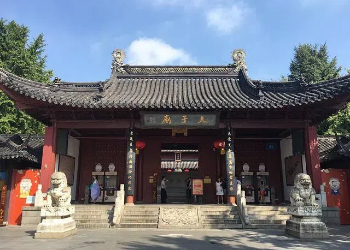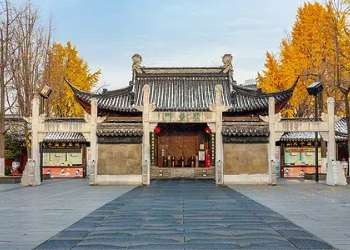 The Confucius Temple
The Confucius Temple
Nanjing Confucius Temple, located on the north bank of the Qinhuai River in Qinhuai District, Nanjing City, Jiangsu Province, is one of the Four Great Confucius Temples in China and a pivotal site for ancient Chinese culture and education. As a grand cluster of historic buildings, Confucius Temple was not only the cultural and educational hub of Nanjing during the Ming and Qing dynasties but also a renowned open-air national AAAAA-level tourist attraction and an international tourist destination in China. The Confucius Temple scenic area mainly consists of three major building clusters: Confucius Temple, the School of Classical Learning, and the Imperial College Examination Hall, occupying a vast area with unique architectural styles. Confucius Temple is a sacred place for honoring and sacrificing to Confucius, within which there are structures such as the Screen Wall, the Pan Pool, the Archway, the Jupiter's Star Pavilion, the Kuixing Pavilion, the Lingxing Gate, the Great Hall of Achievement, the Hall of Virtue and Enlightenment, and the Hall of Respect for the Classics, each embodying profound historical and cultural heritage. This article will provide a detailed introduction to the characteristics of Confucius Temple scenic area, ticket prices, the best travel times, and travel tips, offering a comprehensive guide for your travel planning.
Major Attractions
The Confucius Temple architectural complex is magnificent, primarily comprising attractions such as the Great Hall of Achievement, the Lingxing Gate, the Pan Pool, the Kuixing Pavilion, the School of Classical Learning, and the Jiangnan Imperial College Examination Hall.
Great Hall of Achievement: As the main hall of Confucius Temple, the Great Hall of Achievement is the primary venue for sacrificing to Confucius. In the center of the hall hangs the largest portrait of Confucius in China, surrounded by murals depicting Confucius's life and achievements. Visitors can sense the solemnity and sanctity of Confucian culture here. The ticket price for adults is 30 yuan, and the ticket price for children is 15 yuan (during the Spring Festival, there may be adjustments, such as 35 yuan per person during the day and 50 yuan per person at night).
Lingxing Gate: Before entering Confucius Temple, visitors will pass through this ancient gate. Originally built for sacrificing to heaven, the Lingxing Gate gradually merged with the sacrifices to Confucius and became an important entrance to Confucius Temple.


Pan Pool: The pool in front of Confucius Temple is called the "Pan Pool". The Pan Pool at Confucius Temple was transformed from the Qinhuai River that flows through the square, making it the only Confucius Temple in China with a natural, flowing water body as its Pan Pool.
Kuixing Pavilion: Located beside the Pan Pool, the Kuixing Pavilion is one of the core attractions of Confucius Temple. Kuixing is the god who controls the rise and fall of literary endeavors in Chinese folk beliefs, so the Kuixing Pavilion is also a symbol for scholars to pray for "winning the top spot."
Jiangnan Imperial College Examination Hall: It was the largest and most influential imperial examination venue in Chinese history. Today, the Jiangnan Imperial College Examination Hall has been expanded into the China Imperial Examination Museum, becoming the only professional museum in China reflecting the imperial examination system.


Information
Ticket Price: Entry to Confucius Temple is free of charge.
Location: Intersection of Gongyuan West Street and Gongyuan Street on the north bank of the Qinhuai River in Qinhuai District, Nanjing City, Jiangsu Province.
Service Phone Number: 025-52209788
Travel Tips:
Transportation: Transportation around Confucius Temple is convenient, but the roads within the ancient town are narrow. It is recommended that visitors choose to walk or take a river cruise for sightseeing.
Tour Route: It is recommended to enter through the main gate of Confucius Temple, first visiting famous attractions such as the Great Hall of Confucius and Lingxing Gate, then taking a leisurely stroll along the riverbank to experience the daily life and architectural style of the ancient town.
Food: The snack street near Confucius Temple is a paradise for food lovers, offering a wide variety of delicacies such as duck blood and vermicelli soup, salted duck, and tanghulu.
Cultural Heritage Preservation: During your visit, please respect the local cultural heritage and customs. Do not touch or damage ancient buildings and artifacts.
Safety Tips: The ancient town is crisscrossed with rivers. Visitors should take care while sightseeing, refraining from climbing along the riverbanks or bridges.
Confucius Temple is not only a historical and cultural site but also a cultural journey through time and space. Here, you can feel the profoundness of Confucian culture and appreciate the unique charm of Nanjing as an ancient capital. Whether you are a visitor who loves history and culture or a traveler who enjoys natural scenery, Confucius Temple can satisfy your needs. Come, let's step into this fertile soil of culture together and experience the unique charm of this ancient town.



































